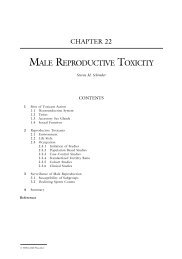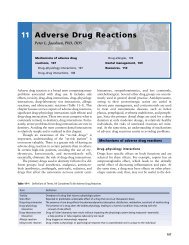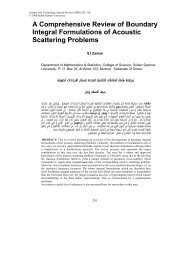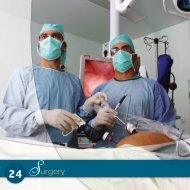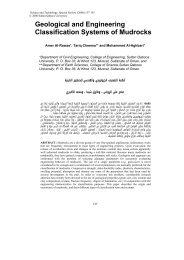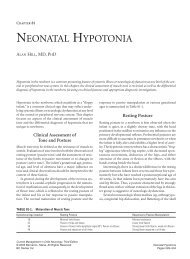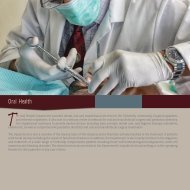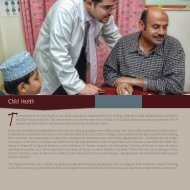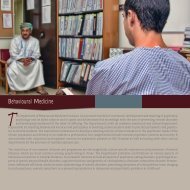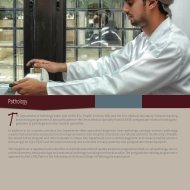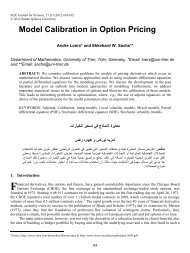(Solanum Tuberosum L.) grown in Oman - Sultan Qaboos University
(Solanum Tuberosum L.) grown in Oman - Sultan Qaboos University
(Solanum Tuberosum L.) grown in Oman - Sultan Qaboos University
You also want an ePaper? Increase the reach of your titles
YUMPU automatically turns print PDFs into web optimized ePapers that Google loves.
EFFECT OF MECHANICAL INJURY AND LOW TEMPERATURE STORAGE<br />
Supplies: α-Solan<strong>in</strong>e and α-chacon<strong>in</strong>e standards were obta<strong>in</strong>ed from Sigma Chemical Co.,<br />
St. Louis, MO, USA. Acetonitrile was HPLC grade from BDH Laboratory supplies (Poole, U.K.).<br />
The water used was deionized and further purified us<strong>in</strong>g the Milli-Q purification system from<br />
Millipore Corp. (Bedford, MA, USA). All other solvents and chemicals used were of standard<br />
analytical grades (BDH Laboratory supplies, Poole, UK).<br />
Chemical analysis: Tuber α-Solan<strong>in</strong>e and α-chacon<strong>in</strong>e content was determ<strong>in</strong>ed us<strong>in</strong>g an<br />
improved version of HPLC procedure described by Hellenas et al. (1995). 12 tubers of uniform<br />
size and without green<strong>in</strong>g or fungal <strong>in</strong>fection were collected from each of the 18 varieties,<br />
cleaned, weighed, and peeled with a domestic potato peeler. Peels of 2 mm thickness were<br />
removed and the ratio of peels to total weight was recorded.<br />
Alkaloid extraction and clean up: The extraction method was a modification of that used by<br />
Hellenas et al. (1995). Details are as follows: samples (10 g) of peel and flesh were mixed with<br />
20 ml of water/acetic acid/sodium bisulphate (NaHSO3), 95:5:0.5 (v/v/w), for five m<strong>in</strong>utes us<strong>in</strong>g<br />
a blender (Moul<strong>in</strong>ex, France). The mixture was diluted to a f<strong>in</strong>al volume of 50 ml with the same<br />
solvent, and was then vacuum filtered through a Whatman No. 1 filter paper. The sample was<br />
cleaned up by centrifug<strong>in</strong>g at 5000g (6500 rpm) for 10 m<strong>in</strong>utes <strong>in</strong> Centrikon T-124 centrifuge<br />
(Kontron, Italy). A SepPak Classic C18 extraction cartridge (Waters Corporation, Milford, MA,<br />
USA) was conditioned by the pass<strong>in</strong>g through of 5 ml of acetonitrile, followed by 5 ml of the<br />
water/acetic acid/NaHSO3 solvent, and a 10 ml sample of the tuber extract was then passed<br />
through followed by 4 ml water/acetonitrile, 85:15 (v/v), for wash<strong>in</strong>g. The glycoalkaloids were<br />
eluted from the cartridge with 4 ml of the acetonitrile/0.022M potassium phosphate buffer, pH<br />
7.6, 55:45 (v/v), and the volume was f<strong>in</strong>ally adjusted to 5 ml with the same solvent.<br />
High Performance Liquid Chromatography (HPLC): α-Solan<strong>in</strong>e and α-chacon<strong>in</strong>e were<br />
separated and quantified us<strong>in</strong>g an HPLC apparatus consist<strong>in</strong>g of a Waters 626 pump, a Waters<br />
717 plus autosampler, a Waters 996 Photodiode Array (PDA) detector, and controlled with<br />
millennium 32 software. The analytical column was a 250 x 4.6 mm id Supelcosil TM LC-NH2 5<br />
µm (Supleco Park. Bellefonte, PA, USA). The mobile phase was acetonitrile/0.022 M potassium<br />
dihydrogenphosphate (KH2PO4) buffer, pH 4.7, 75:25 (v/v) pumped at a flow rate of 1.0 ml m<strong>in</strong> -1 .<br />
The column effluent was monitored for UV absorption at 200 nm wavelength and 0.05 AUFS<br />
sensitivity. The volume of the <strong>in</strong>jected samples was 20 µL. The retention times for α-chacon<strong>in</strong>e<br />
and α-solan<strong>in</strong>e were approximately 7 m<strong>in</strong>utes and 10 m<strong>in</strong>utes, respectively. α-Solan<strong>in</strong>e and αchacon<strong>in</strong>e<br />
concentration <strong>in</strong> sample extracts were quantified by compar<strong>in</strong>g the peak areas with<br />
those of <strong>in</strong>jected known amounts of pure standards. Recovery of glycoalkaloids (Sigma) that were<br />
added to samples averaged (93%).<br />
Mechanical Damage: Potato tubers of each variety without any mechanical and pathological<br />
<strong>in</strong>juries were randomly selected and hand washed prior to treatments. Four treatments <strong>in</strong>clud<strong>in</strong>g<br />
controls and three types of mechanical <strong>in</strong>juries on potato tubers were arranged. There were three<br />
replicates. The mechanical <strong>in</strong>jury treatments <strong>in</strong>cluded dropp<strong>in</strong>g, punctur<strong>in</strong>g with a nail and<br />
cutt<strong>in</strong>g. Dropp<strong>in</strong>g was done by dropp<strong>in</strong>g each tuber 6 times from a height of 2 m, cutt<strong>in</strong>g was<br />
done by cutt<strong>in</strong>g l<strong>in</strong>es 1 cm deep and 1 cm apart <strong>in</strong>to tubers (6 l<strong>in</strong>es/tuber) and punctur<strong>in</strong>g was<br />
done by mak<strong>in</strong>g a hole of 3 mm diameter to the depth of 1 cm with two holes cm -2 (max. 10 holes<br />
tuber -1 ). Zero time samples were taken from each variety. Tubers were sampled immediately and<br />
after 7, 14 and 21 days of storage. Peel and flesh were separated and analyzed for their<br />
glycoalkaloid content.<br />
Temperature: Tubers from each variety were randomly selected and hand washed prior to<br />
treatments. Three replicates from each variety were stored at the follow<strong>in</strong>g temperatures:<br />
Constant 4 ºC for 0, 2, 4, 6 weeks, constant 10 ºC for 0, 2, 4, 6 weeks, variable: a) 3 weeks at 4 ºC<br />
followed by 3 weeks at 10 ºC and b) 3 weeks at 10 ºC followed by 3 weeks at 4ºC.<br />
Peel and flesh tissues were separated and analyzed for their glycoalkaloid content.<br />
85





